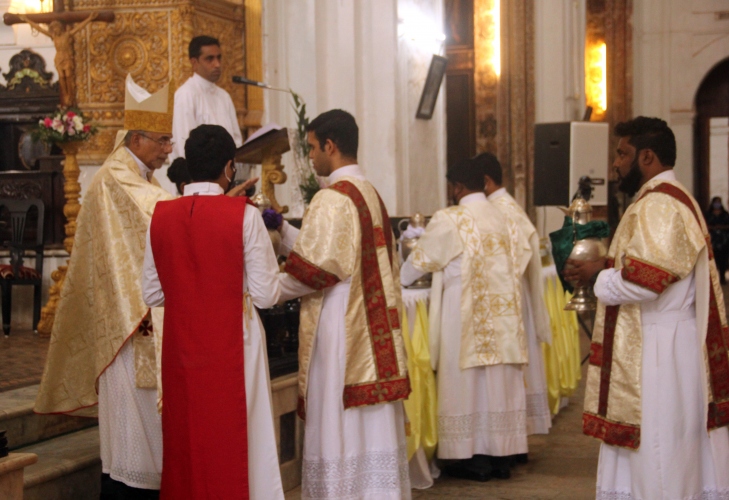
Fr Walter de Sa
The Season of Lent that began with Ash Wednesday leads the faithful to the Holy Week which comprises Palm Sunday, Maundy Thursday, Good Friday and Holy Saturday.
Maundy Thursday, also known as the Thursday of the Lord’s Supper, marks the institution of the Eucharist, of the Priesthood and of the new commandment (Mandatum Novum).
The liturgy of the Holy Thursday prescribes a special Mass of the Chrism in the morning, reinstituted by Pope Pius XII, distinct from the evening Mass of the Lord’s Supper.
Liturgical reforms permit that the Chrism Mass may be anticipated and celebrated on another day on genuine grounds. However, the anticipated Chrism Mass should be near to Easter.
This year, the Church in Goa celebrated the anticipated Chrism Mass on March 24 at the Se Cathedral, Old Goa. In the past, this Mass used to be celebrated on a Thursday preceding Holy Thursday. However, due to the Solemnity of the Annunciation of the Lord, scheduled on Thursday (March 25) in the Liturgical Calendar, the Chrism Mass was fixed for March 24.
THE PURPOSE
The Chrism Mass expresses more clearly the presbyterial communion of the priests with their Bishop who presides over the Mass.
At this Mass, the Bishop blesses the Oil of the Catechumens (Oleum Catechumenorum) and the Oil of the Sick (Oleum Infirmorum), and consecrates the Holy Chrism (Sacrum Chrisma). As the Bishop says the prayer of consecration, the concelebrants extend their right hands towards the jars of Chrism, a gesture that signifies that, together with their Bishop, they too participate “in the authority by which Christ Himself builds up, sanctifies and rules His body.”
The concelebrating priests stand as co-workers of their Bishop. In this manner, the unity of priesthood and of the sacrifice of Christ the Redeemer is visibly manifest.
Each prayer of blessing expresses a characteristic feature of the power and effect of each oil. The Oil of the Catechumens strengthens the individual to renounce the devil and sin. The Oil of the Sick has the power to recuperate health and obtain forgiveness of sins. The Holy Chrism makes the candidates sharers in the triple function of Christ.
The Oil of the Catechumens is used in baptism, while the Oil of the Sick is used for the sick and the Holy Chrism is used in baptism, confirmation, ordination of priests and Bishops. It is also used in dedication ceremony of a new Church, anointing of the altar, walls of the Church marked by crosses.
The oils to be blessed need not be necessarily olive oil. Any vegetable or plant oil can be used. In Goa, sunflower oil is used for blessing and the quantity of oil required for distribution to churches in Goa is around 60 kgs. These oils are blessed once in a year, and to be used during that particular year. These oils are to be preserved with reverence and honour and used for intended purposes.
According to the liturgical rubrics, the old oils are to be burnt or poured into the Blessed Sacrament lamp.
THE CEREMONY
The Deacons in appropriate vestments, carrying silver jars filled with oil, dressed in purple, green and white cloth, along with priests and the Bishop, enter processionally into the Church, and place the jars on a table kept near the main altar.
During Mass, in which the blessing rite of the oils is integrated, the Bishop addressed the priests, reminding them to be faithful to the munus conferred on them on the day of their ordination, and inviting them to renew their priestly promises publicly.
The promises refer to be more closely conformed to the Lord Jesus, to be faithful stewards of the Sacraments, and to discharge the responsibilities and duties in imitation of Christ the Shepherd who came “not to be served but to serve.”
The Bishop also appealed to the people during the Chrism Mass, to pray not only for their priests but also for himself in the faithful discharge of the apostolic office entrusted to him, as a Good Shepherd, a Teacher and a Servant of all.
Following an ancient tradition, the Oil of the Sick was blessed before the end of the Eucharistic Prayer while the Oil of the Catechumens and the Holy Chrism were blessed after Communion.
After the Chrism Mass, the Bishop and the priests generally meet for a fraternal agape meant for further bonding of the Unum Praesbiterium.
(The writer is Parish Priest of Our Lady of Immaculate Conception Church at Panaji)
Reach out to people in kindness: Archbishop to priests
OLD GOA: Archbishop Filipe Neri Ferrao on Wednesday called upon priests to be caring shepherds, to serve people with a joyful heart and to be instruments of God’s mercy and kindness.
Archbishop Ferrao was delivering his homily during the annual Chrism Mass of the Archdiocese of Goa and Daman at Se Cathedral Church, Old Goa. Bishop Emeritus of Port Blair Alex Dias and priests representatives from all over the Archdiocese were con-celebrants in the Chrism Mass.
Like Christ, Archbishop Ferrao invited the priests to share in the joys and pains of their people and reach out to them in all kindness.
The Chrism Mass ended with the releasing of Pastoral Diary for the coming Year. The Pastoral Diary which has the schedule for major events in the Archdiocese has been prepared under the direction of Pastoral Secretariat of the Archdiocese.